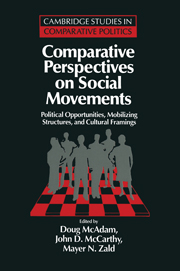 Comparative Perspectives on Social Movements
Comparative Perspectives on Social Movements Book contents
- Frontmatter
- Contents
- Biographical sketches of contributors
- Preface
- Introduction: Opportunities, mobilizing structures, and framing processes – toward a synthetic, comparative perspective on social movements
- PART I POLITICAL OPPORTUNITIES
- 1 Conceptual origins, current problems, future direction
- 2 States and opportunities: The political structuring of social movements
- 3 Social movements and the state: Thoughts on the policing of protest
- 4 Opportunities and framing in the Eastern European revolts of 1989
- 5 Opportunities and framing in the transition to democracy: The case of Russia
- PART II MOBILIZING STRUCTURES
- PART III FRAMING PROCESSES
- Notes
- References
- Index
2 - States and opportunities: The political structuring of social movements
Published online by Cambridge University Press: 05 June 2012
- Frontmatter
- Contents
- Biographical sketches of contributors
- Preface
- Introduction: Opportunities, mobilizing structures, and framing processes – toward a synthetic, comparative perspective on social movements
- PART I POLITICAL OPPORTUNITIES
- 1 Conceptual origins, current problems, future direction
- 2 States and opportunities: The political structuring of social movements
- 3 Social movements and the state: Thoughts on the policing of protest
- 4 Opportunities and framing in the Eastern European revolts of 1989
- 5 Opportunities and framing in the transition to democracy: The case of Russia
- PART II MOBILIZING STRUCTURES
- PART III FRAMING PROCESSES
- Notes
- References
- Index
Summary
In a 1991 article, John McCarthy, David Britt, and Mark Wolfson begin with an assertion that is often acknowledged in the social movement field but seldom receives the attention it deserves. They write:
When people come together to pursue collective action in the context of the modern state they enter a complex and multifaceted social, political and economic environment. The elements of the environment have manifold direct and indirect consequences for people's common decisions about how to define their social change goals and how to organize and proceed in pursuing those goals. (1991: 46)
Their observation reflects the findings of a loose archipelago of writings that has developed since the early 1970s around the theme of “political opportunity structure.” In his introduction to this part, Doug McAdam points out that, rather than focus on some supposedly universal cause of collective action, writers in this tradition examine political structures as incentives to the formation of social movements. But there are two major ways of specifying political structures in relation to collective action: as cross-sectional and static structures of opportunity and as intrasystemic and dynamic ones. This essay briefly discusses both but explores in much greater depth why – in my view – “dynamic” opportunities appear to impinge more directly on the decision-making of social movements and permit them to create their own opportunities.
A TYPOLOGY OF OPPORTUNITY STRUCTURES
As in any developing paradigm, there is a healthy and many-sided debate about how to conceptualize political opportunity structure. Some researchers have focused on large-scale structures, others on ones that are proximate to particular actors; some analyze cross-sectional variations in political opportunity, while others look at how changes in political conflict and alliances trigger, channel, and demobilize social movements.
- Type
- Chapter
- Information
- Comparative Perspectives on Social MovementsPolitical Opportunities, Mobilizing Structures, and Cultural Framings, pp. 41 - 61Publisher: Cambridge University PressPrint publication year: 1996
- 280
- Cited by


